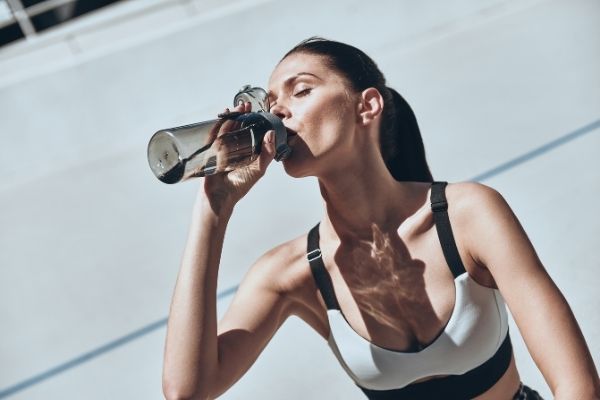It’s Time to Rethink Endurance Fueling and Hydration
By Cindy Abrami, NASM-Corrective Exercise Specialist, UESCA Running and Multisport Coach and holds a BS in Nutrition
When it comes to long endurance events, and training for them, figuring out a nutrition plan that works specifically for your physiology is just as important as any other part of your training and preparation.
There is no shortage of anecdotal information on “during competition” fueling and if you ask fellow athletes about it, you’ll find there is no shortage of opinions.
Prolific information and opinions often lead to trends that are not necessarily research based, but rather are based on informal rules that everyone seems to assume is best. Therefore, as with all things pertaining to OURSELVES, it is important to be proactive and ask the right questions and to be willing to investigate popular opinion and to include logic and intuitive thinking. Until this happens, there will be a tendency for athletes to make big mistakes when it comes to in-competition (and long training) nutrition.
Recently, within the past couple of years, I’ve come across a few brave souls who’ve had the courage to rethink the idea of fueling during exercise. They challenge the assumption that engineered nutrition (otherwise known as fake processed “sport” foods) is the best way to fuel. Being the “whole food is always best” proponent that I am, I have felt a sudden kinship with this segment. Also, I already discovered that concentrated carbohydrates (sugar) and liquid calories were never going to work for me and I was already experimenting with the forbidden. I keep threatening to eat bacon on our next long ride. That’s usually what I’m craving 2 ½ hours into it! My traditionally minded training buddies roll their eyes.
Let’s get down to specifics and have a quick discussion of nutrition and receive some sound advice from experts and research.
The Current Trend
The current predominant choice for long competition and long training fuel includes concentrated shots of pure sugar (gels, gu’s, gummy equivalents), high sugar sports drinks, and powdered carbohydrate products designed to be mixed with water. Many athletes seem to be a bit obsessed with sugar and the fear of bonking. In many cases, athletes also over consume calories during training and become locked into the idea that they need food even during shorter workouts. Additionally, sports drinks are often consumed on a regular basis, even outside of active training. In other words, athletes have a tendency to load their systems with sugar. The big question: How’s that working for you? Check out some research.
How can we do better?
- Avoid any type of engineered nutrition product that doses your body with pure sugar, particularly when under the stress of competition or training.
In a 2017 article (that’s well worth reading), Alex Hutchinson talks about Felicity Thomas, an athlete and undergrad at the University of Canterbury, who embarked on a PhD studying the potential of monitoring blood sugar to prevent bonks. She published a study in 2016 (in the Journal of Diabetes Science and Technology) and the outcome wasn’t what she expected. The study looked at 10 endurance athletes who exercise at least 6 hours per week and had them on continuous blood glucose monitoring across 6 days. Three out of the 10 athletes were found to have fasting blood glucose levels that were in the pre-diabetic range (100/125 mg/dL). This is a precursor to diabetes. The author of the study concluded that more investigation into diet is needed to better determine the cause of the hyperglycemia, however she suspects that a key contributor is that endurance athletes tend to consume too many sports drinks and energy gel products, repeatedly flooding their bodies with a glucose overload.
While none of this is conclusive, it brings to light that athletes, just like everyone else, should not be consuming concentrated sugar, particularly if they do it regularly. Many athletes consume gels and high sugar sports drinks, or other high sugar products on a daily basis or at least several times a week. According to a 1989 study, Tour de France riders consume a pound of sugar a day, and a study of Kenyan runners found that they get 20% of their calories from the sugar they heap into their tea and porridge. High sugar diets are not good. They’re not good for anyone and athletes are not immune to related adverse health effects. We’ll likely see more research in the area of sugar consumption and its effect on athletes in the near future as there is a lot of interest in this area, and rightly so.
Dr. Stacy Sims, an environmental exercise physiologist and nutrition scientist, agrees that gels are not good for anyone. She states “When we think about all this engineered nutrition, you’re taking concentrated carbohydrates and putting it in this compromised gut.” She’s referring to our gut during exercise stress and she points out that gels and other high, concentrated carbohydrate products create a shifting of fluid into the small intestines. Fluid is diverted to the gut to process the load of sugar. This causes the common feeling of bloating and hastens dehydration during a highly vulnerable time.
She goes on to say, “Having that kind of pure sugar is really never good for you. You should make sure your overall food strategy and training food strategy match. Is a gel how you typically eat? No. They why eat it under the stress of exercise.”
Dr. Sims suggests consuming real food instead. Our bodies know what to do with real food and because there is a mix of macronutrients in real food, gastric emptying and the digestive process is slowed such that there is more sustained energy delivered to working muscles and stabilized blood glucose.
- Make sure your nutrition and your hydration are separate.
Dr. Sims, in discussing fuel and hydration, points out that athletes need to maintain appropriate blood volume in order to best sustain their effort. Calories are important, and so is hydration. But you can’t have both within one product. “Combining sugar, amino acids, fuel substances into your drink which is supposed to be your hydration is counter-productive.” This is how many athletes become dangerously dehydrated even though they have been consuming fluids. As they consume it, fluid is simultaneously being pulled out of the blood stream into the gut to deal with the fuel sitting in there.
She recommends consuming water with essential electrolytes (particularly a little salt, potassium and a little sugar) which will pull the fluid into the blood stream. And consume food separately and in small amounts. As she puts it: Sip, sip, nibble, nibble.
- Make sure that you go into a competition (or a long training event) pre-loaded, having fueled with healthy carbohydrates (not refined sugars or processed carbohydrates), and make sure to top off your sodium by salting food. And then restock your nutrition post-exercise.
Dr. Sims points out that if you’re properly fueled going into your event or training, you don’t need to eat as much as you think and you don’t need to worry about consuming salt tablets during a race. Cramping during a race, often thought to be related to a need for salt, is not usually about salt. It’s more about other electrolyte imbalances (or other causes), as we tend to sweat out calcium and hold onto magnesium, and one of the best ways to deal with them is to eat some Tums (calcium and magnesium).
Post-exercise is the time to then restock your body with salt, protein and carbohydrates. And once again, eating real food is the best way to do this. Engineered nutrition recovery products can have substances that you should not be consuming. An example is products that contain antioxidants. Post-exercise your body is in a process of adapting to the stress, otherwise known as building fitness. Part of this adaptation process is your body dealing with the oxidative stress related to exercise. By consuming concentrations of antioxidants, your body’s natural adaptation is inhibited. You block it.
Let’s Sum it All Up!
Here are some great takeaways to leave you with so that you can make educated decisions and begin finding your best fueling strategy:
- Eat real food, not engineered nutrition. Your food choices should be those high in healthy carbohydrates, with some protein and fat to help regulate digestion and entry of glucose into the bloodstream. The hotter the temperature, the less fat you should consume.
- Some great fuel choices to try: bananas, cooked white potatoes, cooked sweet potatoes, try creating a mash or small bite sized pieces for easy consumption. You can add small amounts of healthy fat (coconut oil for instance), walnuts, seeds. Experiment with real food in training and find what works for you.
- Use water for exertion up to an hour, but for more intense or longer efforts, include some electrolytes (nothing high in sugar – Nuun Tablets are a great one to try). You can generally drink to thirst for the first 2 hours and ensure you’re sipping fairly regularly but after that your thirst becomes a poor indicator of hydration, so you should begin to drink on a schedule.
- For optimal recovery, consume real food post-exercise that is high in carbohydrate and protein. Add salt to fruits to increase natural hydration. Seek to get some food into your system within 30 minutes if you’re female, and within an hour if you’re a male, and then follow that up with a full meal as soon as possible.
No one strategy works for everyone! Have fun finding out what works for you!
_____________________________
About the Author: Cindy Abrami, BS Nutrition, NASM-CPT/CES, AFAA, Pn1 Nutrition Coach, UESCA Certified Running and Multisport Coach, Schwinn Certified Indoor Cycling Instructor

